Claussen Pickles are kosher dill pickles at their crunchiest, saltiest best! These homemade Claussen pickles taste like the commercial ones you find at the store, but better. And better yet, they’re ridiculously easy to make!
Whether you’re new to pickle making or a pickle veteran, you NEED to make these half sour pickles! And wonder of wonders, you don’t need to know how to can to make these super fresh, crunchy pickles! Claussen dill pickles are meant to be eaten fresh.
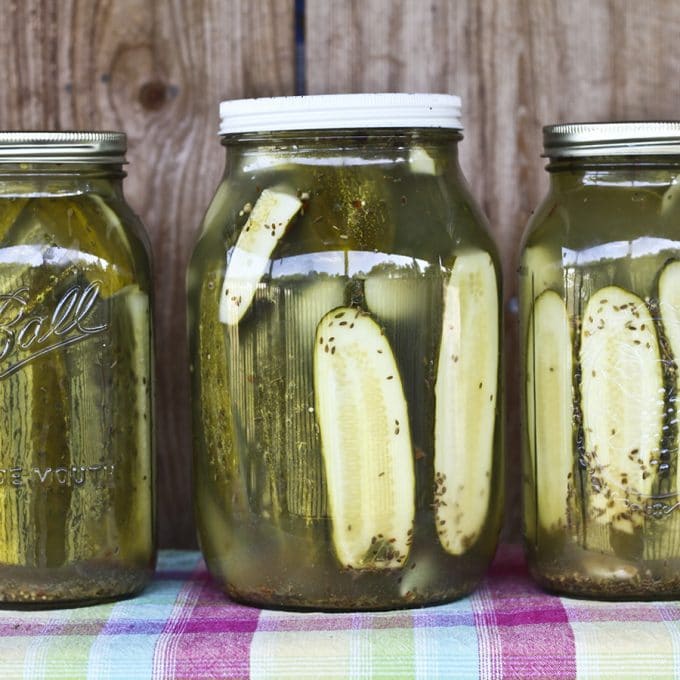
Homemade Claussen Knock-Off Pickles: Always crunchy and garlicky, this perfect homemade pickle recipe requires no special equipment, & no canning experience.
It’s common knowledge that I have a salty tooth rather than a sweet tooth. When the weather does what it has been doing lately (making us all do our best Shadrach, Meshach and Abednego impersonations) I can’t think of a single thing I find more refreshing than an icy-cold, salty, crunchy pickle.
It’s not just me, it’s my whole family: mother, sisters, brothers, cousins, aunts, grandparents, kids, husband… I married a man who loves pickles so much he eats the pickles and then drinks the juice from the jar.
I grew up eating my Grandma’s homemade dill pickles like the supply was endless and moved on to canning my own pickles as soon as I had a kitchen of my own. There’s just something about a homemade dill pickle that makes me happier than any pickled cucumber ever should.
My little sister, Jessamine, and I compare our homemade pickles from year to year the way some people compare wine vintages.
Dill Pickle Recipe
But there is one pickle that stands head-and-shoulders (were pickles to *have* heads and shoulders) above all others. I’m talking about the pickles you see here. That’s right: Homemade Claussen Dill Pickles.
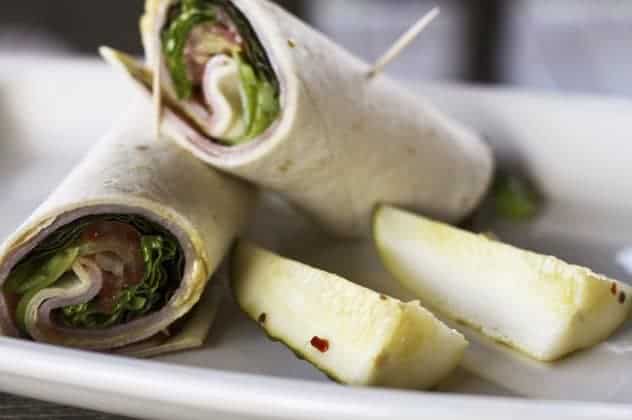
Recipe for Claussen Pickles
What do you need in order to make this recipe for Claussen Half Sour Pickles at home? Let’s get a quick list for both ingredients and equipment out of the way, shall we?
Equipment for Making Claussen Pickles at Home
- A Glass gallon jar or 4 glass quart jars or other food safe container with a tight fitting lid
- Measuring cup
- Chef’s knife or paring knife
Ingredients for Making Homemade Claussen Pickles Copycat
- Small to medium size pickling cucumbers (check your local farm stand or farmer’s market!)
- Apple Cider Vinegar (don’t fret- it doesn’t taste like apple cider and isn’t even a little sweet!) or white vinegar
- Kosher Salt
- Garlic
- Dill (either fresh or dill seed)
- Pickling spices (available here)
A quite note on your vinegar choice: I opt for apple cider vinegar because it’s a smoother vinegar than white vinegar. It does not impart any sweetness or apple taste to the pickles whatsoever.
If you can’t find it (pssst. It’s right next to white vinegar in even moderately stocked grocery stores) or don’t feel like buying it, you can most certainly substitute white vinegar. It’ll just taste a little sharper. (And technically store bought Claussen pickles have white vinegar, so you do you!)
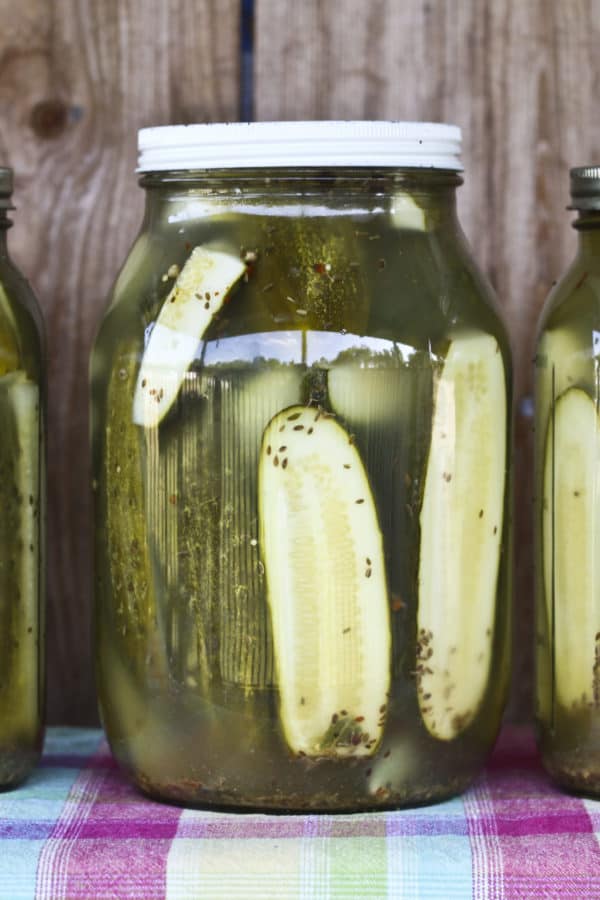
And ya’ll. These homemade half sour pickles are so easy to make it’s almost criminal.
The hardest part is the 2 to 4 day wait for them to be done. Truth be told, though, I’ve snacked on them the day after I made them and been a very happy camper.
Claussen Pickle Recipe
These are homemade refrigerated deli pickles, also known as Lithuanian half-sours, also known (in the commercial equivalent) as Claussen dill kosher pickles, also known as the best pickles ever known to mankind.
Here’s the thing. While I do love my other homemade pickles dearly (otherwise why would I continue canning ninety-something quarts year after year after year), these are by far my all-time favourites.
CRUNCH. That’s what you hear when you bite these. There is no flop, no squish, no soft pickles. These things almost bite back.
This also happens to be the perfect dill pickle recipe for beginning pickle makers. If you’re not into canning, these refrigerator pickles are a godsend. Even if you ARE canning obsessed, like yours truly, this Claussen pickle recipe should be in your pickle repertoire too.
Please note that this Claussen pickle recipe is not suitable for canning. The brine is fermented and not very acidic, which means it has far too high a PH to can safely. If you’re looking for a great canned dill pickle recipe, try this home canned garlic dill pickle recipe.
Refrigerator Pickles
Here’s where we get into the best part of this pickle recipe (aside from the crunch and flavor). You don’t have to cook anything to make these pickles; not one single thing. The brine is stirred together, the cucumbers are rinsed, trimmed and stuffed into a jar with garlic cloves and spices.
These half sour pickles are NOT CANNED. They are simply put into jars. Amen!
When it’s summer time and the idea of turning on the stove makes me want to crawl into an (air conditioned) hole, these pickles are a welcome treat. Not only is that cold crunchy refrigerator pickle waiting to cool me off at the end of the prep time, but I don’t have to heat up my kitchen by even one single degree to get there.
Remember that pickling isn’t just for cucumbers, either! Try out our Pickled Brussels Sprouts, Quick Pickled Red Onions, and famous Candied Jalapenos!
How to Make Pickles FAQ
Please, please, please give these a go even if you have never made a pickle before. There is nothing scary or intimidating here. Wash, slice, stuff, stir, pour, sit, wait.
- Trim 1/8-inch from the blossom end of each cucumber and slice them in half lengthwise or into quarters. The size you choose depends on how large your cucumbers are and how big you want the pickles to be when they’re done. This helps minimize the chances of soft pickles.
- In a gallon jar (or large, wide-mouth, food-safe container) layer the dill heads or seed, pickling spice or mustard seed, and garlic cloves and sliced cucumbers. If you’re dividing the cucumbers up between smaller containers, just divide the garlic and spices evenly between the containers, too.
- Stir your brine together in a separate container. You WILL have more brine than you have space for in the jars, but that’s why you pack the spices in the jars. Just store extra brine in a jar in the refrigerator and use it to top off your pickles if the brine starts evaporating.
- Pour the brine over the cucumbers, taking care to make sure all of them are fully submerged. If needed, place a plate or mug or other ziploc bagged can of beans on the cucumbers to weigh them down and keep them under the brine!
- Cover the jars lightly not tightly and leave out of direct sunlight on the counter for two to four days or until the pickles are picklicious.
- If your kitchen is pretty hot or humid, you can stash them directly in the refrigerator. They’ll just take a couple of days longer to get fabulous. Your patience will be rewarded.
On the plus side, the wait is only two to four days which is significantly less than the six week wait of the canned pickles. Besides, as I said, there is the crunch factor
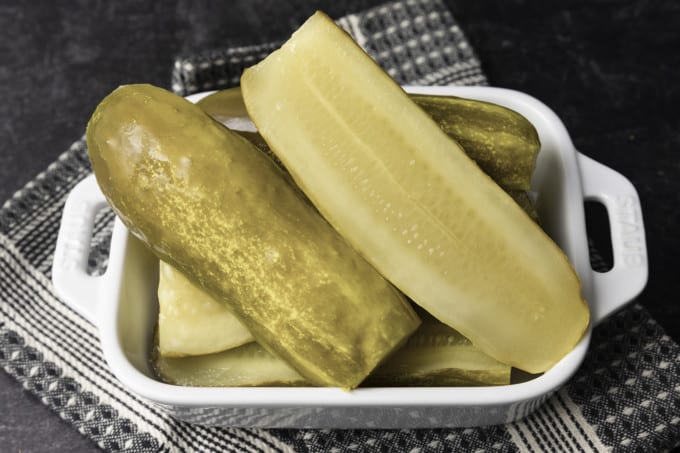
Troubleshooting Your Homemade Claussen Pickles
These pickles are easy peasy to make, but there still may be a couple of things that pop up from time to time that make you go “Hmmm…” In no particular order, here are some of the most commonly asked questions about them and some answers!
- Why is my pickle brine cloudy? Okay, I lied. This is the most common question and that’s because the brine becomes cloudy naturally as a consequence of fermentation (which is what’s happening here.) No worries.
It’s all natural. This half sour pickle recipe (more on this to come) is a fermented pickle recipe and that just happens.
Another possible cause of intense cloudiness or discolouration in your brine is using table salt. The iodine in table salt can also give off flavours to your pickles, so it’s best to stick with kosher salt or pickling salt for these bad boys! - Is the scum, foam, or film on top of my pickle brine dangerous? It’s that pesky (and delicious) fermentation again! This is another thing you don’t have to worry about.
Just scrape it off with a spoon, discard, and top off with a little of that extra brine you whipped up. (See the recipe card for details.) But do remove the scum or it could cause your pickles to go bad. - My pickles went soft! How do I prevent this? This particular tragedy could have two causes.
First, you may have failed to remove enough of the blossom end of the cucumber. There is a naturally occurring enzyme in the blossom end of cucumbers that causes pickles to break down and become soft if it is not removed. Next time, just slice more off.
Second, you may have started with less than spectacularly fresh cucumbers. An older cucumber has had longer for the aforementioned enzyme to kick in, and it has already started its work.
The best solution for this issue is to use cucumbers that have either been picked fresh that day or have been refrigerated steadily since very shortly after being picked a couple of days previously. - Why did my pickles go bad? See that second reason in the “why did my pickles go soft” bullet point? That’s one culprit.
Other potential causes of spoiled pickles are using unwashed cucumbers or fresh dill, old or decayed garlic, bad spices, lower-than-5%-acidity-vinegar, failing to remove the scum from the brine or to keep the pickles submerged in the brine, or storing your pickles in warmer conditions. When in doubt, stash them in the refrigerator! - Why is there mold on my pickles? First, you have my condolences. Second, it’s because your pickles didn’t stay submerged in the brine. That brine has enough salt and acid to prevent mold growth if the cucumbers stay under the surface.
If you’re having trouble finding something that fits in the jar to keep this from happening, try popping a can or two of tomato paste or canned beans in a zipper top bag and gently inserting that into the jar. It should weigh it down enough to do the job. - Should I worry about the white sediment in my jar? This is another one in the “don’t sweat it” category. There are two potential reasons and both are completely harmless.
It’s either a natural consequence of the fermentation or anti-caking agents in the salt. Neither harms the pickles or effects the flavour, so don’t worry! - Why is my garlic blue/green/purple? As long you inspect the garlic before it goes into your jars and it is fresh as a daisy, you have nothing to worry about. It could be the type of salt you used or it could be the variety of garlic. Some types of garlic have a natural propensity to change pretty colours in vinegar.
It also may mean that your pickles were exposed to light. When garlic is exposed to light, it starts producing chlorophyll which is green. It also may indicate that your garlic is more mature.
In that case it is caused by sulfur compounds that naturally occur in more mature garlic reacting with minute traces of copper in the vinegar., but as long as there are no other signs of spoilage (soft or squishy texture, funky smell, discoloured spots), you’re good to go.
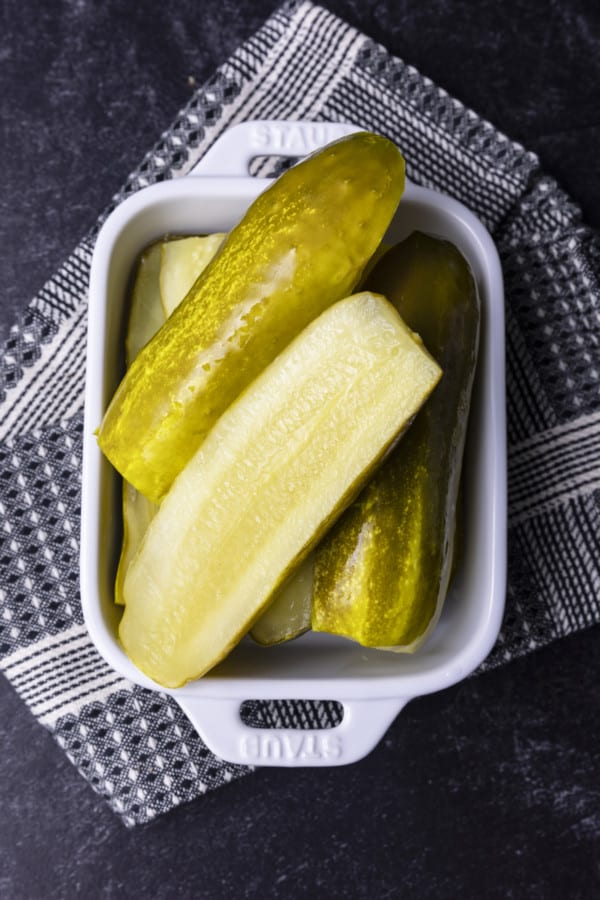
IMPORTANT NOTE: Because there is so much diversity in temperature, humidity, age of cucumbers, etc… involved in this recipe, please check your half sour pickles starting at 24 hours for doneness. If the pickles smell/taste pickley, move them to the refrigerator. Do not keep them on the counter longer than 4 days.
ANOTHER IMPORTANT NOTE: These pickles are not suitable for canning. They’re simply not acidic enough to can safely, and that is in addition to the fact that you’d ruin that perfectly crisp texture by introducing heat to the party.
What can I serve with these Homemade Claussen Knock-Off Pickles?
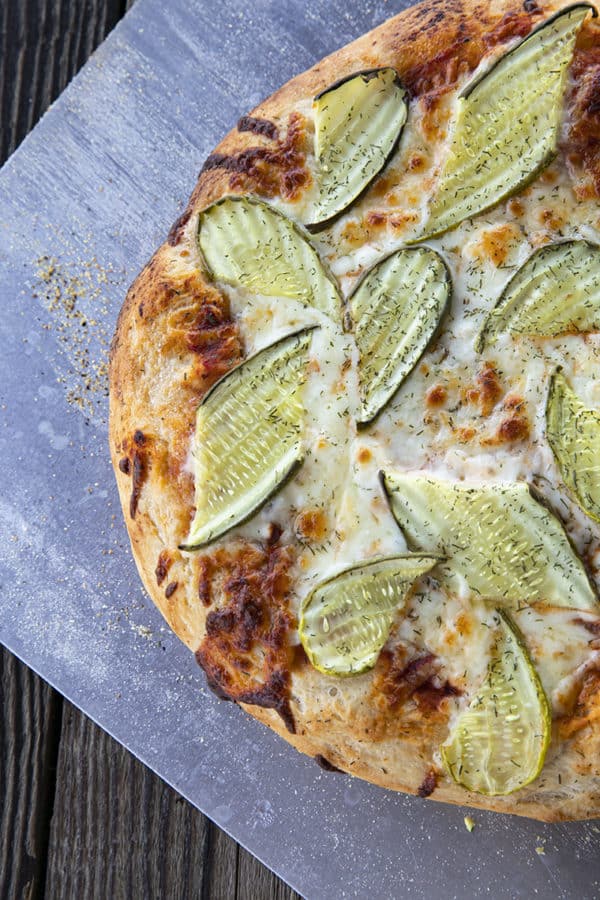
Start out by trying your half sour pickles in this Pickle de Gallo, Dill Pickle Dip, Dill Pickle Egg Salad, or Bagel Burgers with Dill Pickle Cream Cheese.
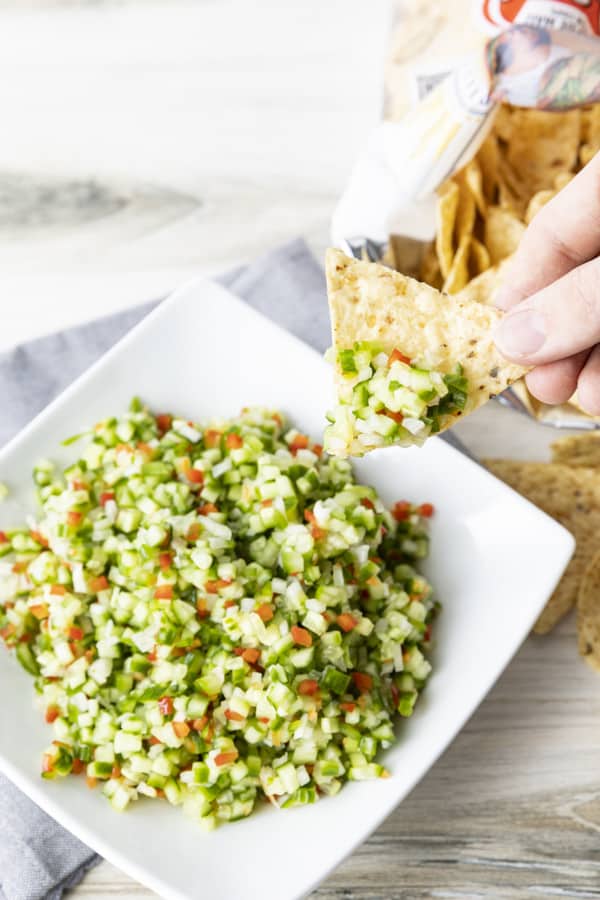
Even better, serve them on our Cheeseburger Salad or Pickle Pizza.
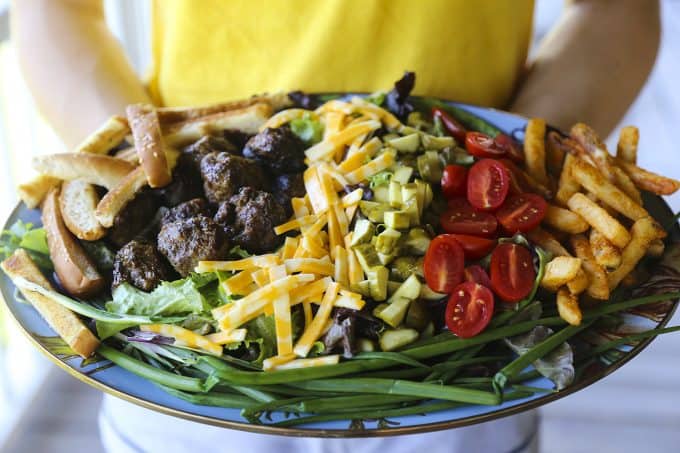
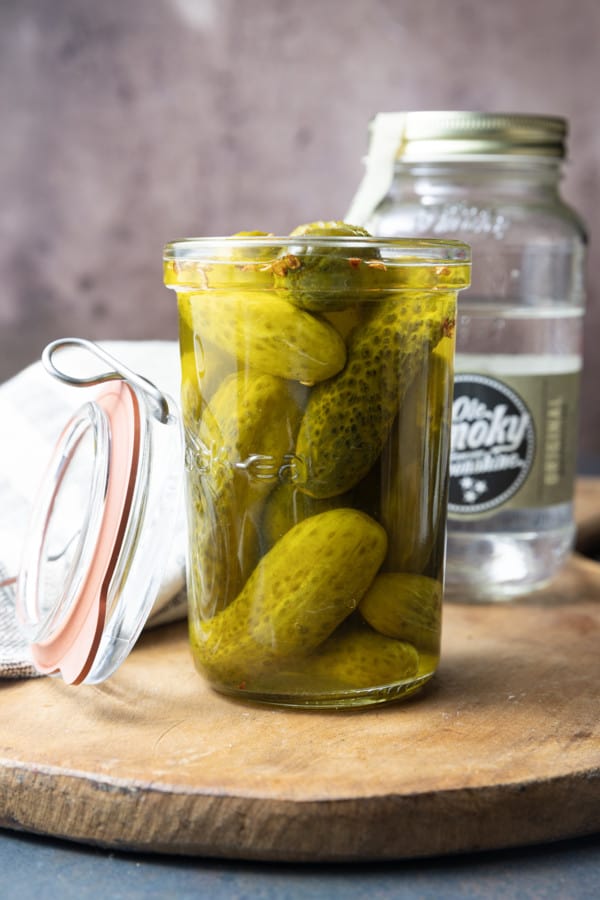
You can even take extra pickles (like that’s a thing!) and make these divine Moonshine Pickles. You’ve never had a better Bloody Mary than one made with homemade Moonshine Pickles!
Half Sour Pickle Recipe
What makes Claussen PIckles different from canned pickles? Claussen pickles, whether homemade or store bought, are a half sour pickle recipe.
That means they’re fermented instead of heat processed. That’s what gives them such great texture.
This half sour pickle recipe yields pickles that are crunchy to the point of making noise when you bite them, cold, and seriously garlicky. Canned, shelf-stable pickles can be chilled, maintain some crunch, and be as garlicky as you want them to be, but they are never, ever going to be the same thing because of science.
When you heat process a jar of pickles you are, in actuality, cooking it and a cooked pickle just plain can’t be as crunchy as an un-cooked half sour pickle recipe.
These homemade pickles keep well in the fridge for about six months, as long as they remain submerged in the brine. In our house, they never last that long because, as the saying goes, “A pickle a day keeps sad times away.”
They say that right? Someone must. If not, I’m going to start. It’s true, after all.
Claussen Pickles
Wash cucumbers but do not scrub them.
Trim 1/8-inch to 1/4-inch from the blossom end of each cucumber and slice in half lengthwise or into quarters, depending on how large your cucumbers are and how big you want them to be when they’re done.
Layer the dill heads or seed, garlic cloves, pickling spices and sliced cucumbers in a gallon jar (or large, wide-mouth, food-safe container). You can evenly divide the dill, garlic cloves, pickling spices, and cucumbers between several smaller jars if needed.
In a separate pitcher or bowl, stir together the remaining ingredients until the salt is dissolved.
Pour the brine over the cucumbers, taking care to make sure all of them are fully submerged. If needed, place a plate or mug or other non-reactive heavy item on the cucumbers to weigh them down and keep them under the brine!
Cover lightly with a lid just perched on top or secure a piece of cheesecloth over the jar with a rubber band to keep fruit flies away. Store any extra brine in a covered jar or pitcher in the refrigerator and use it to top off the brine if it starts to evaporate and expose the pickles to the air.
Leave out of direct sunlight on the counter for at least 24 hours, but up to 4 days, or until the cucumbers taste like pickles throughout.
Fix your lid onto your jar or container and chill thoroughly. These can be stored in the refrigerator for up to six months provided you keep them covered with brine.
NOTE: If at any point in the proceedings “fuzz” or “foam” develops on top of the brine, use a spoon to remove it. If there is “fuzz” attached to any of the cucumbers, remove the ones affected and be sure the others are still fully submerged.
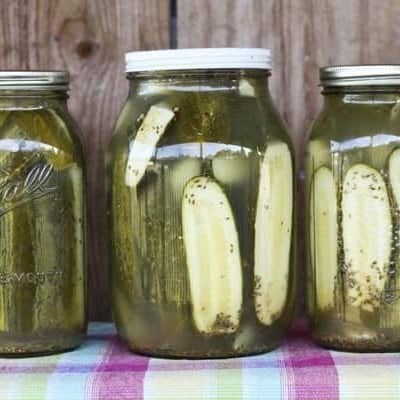
Homemade Claussen Knock-Off Pickles
Equipment
- 1 gallon jar or 4 quart jars or a large, food-safe container with a tight fitting lid
- 1 liquid measuring cup
- 1 large mixing bowl or pitcher
Ingredients
- 35 to 40 small to medium pickling cucumbers
- 1 gallon cold water
- 1 cup apple cider vinegar, preferably raw or white distilled vinegar
- 2/3 cup coarse canning or kosher salt Do NOT fine or use iodized salt!
- 4 cloves garlic or more to taste
- 4 heads fresh dill or 4 tablespoons dried dill seed not weed!
- 2 tablespoons mixed pickling spices
Instructions
- Wash cucumbers but do not scrub them.
- Trim 1/8-inch from the blossom end of each cucumber and slice in half lengthwise or into quarters, depending on how large your cucumbers are and how big you want them to be when they’re done.
- In a gallon jar (or large, wide-mouth, food-safe container) layer the dill heads or seed, garlic cloves, pickling spices and sliced cucumbers.
- In a separate pitcher or bowl, stir together the remaining ingredients until the salt is dissolved.
- Pour the brine over the cucumbers, taking care to make sure all of them are fully submerged. If needed, place a plate or mug or other non-reactive heavy item on the cucumbers to weigh them down and keep them under the brine!
- Cover lightly with a lid just perched on top or secure a piece of cheesecloth over the jar with a rubber band to keep fruit flies away.
- Leave out of direct sunlight on the counter for two to four days*, or until the cucumbers taste like pickles throughout.
- Fix your lid onto your jar or container and chill. These can be stored in the refrigerator for up to six months provided you keep them covered with brine.
- *If at any point in the proceedings “fuzz” or “foam” develops on top of the brine, use a spoon to remove it. If there is “fuzz” attached to any of the cucumbers, remove the ones affected and be sure the others are still fully submerged.
Notes
Nutrition
Nutritional information is an estimate and provided to you as a courtesy. You should calculate the nutritional information with the actual ingredients used in your recipe using your preferred nutrition calculator.
did you make this recipe?
Make sure to tag @foodiewithfam on Instagram and #hashtag it #foodiewithfamily so I can check it out!
Originally published July 22, 2011. Updated with FAQs and Troubleshooting and reposted August 2022.
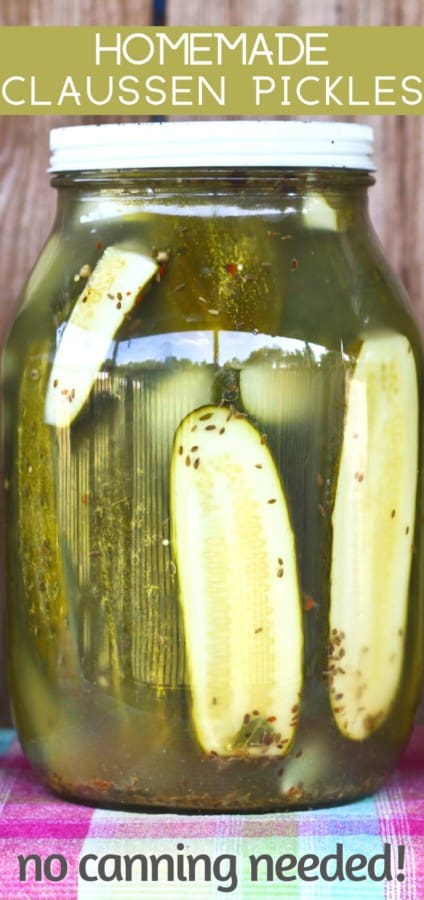
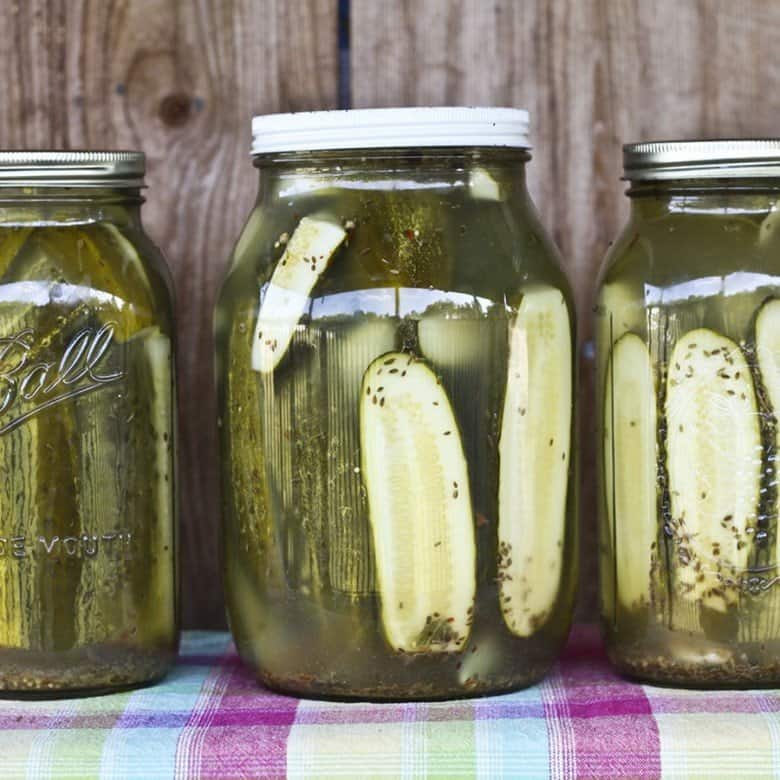
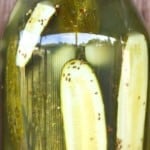



Reader's Thoughts...
Melanie says
I am an American ex pat who lives in the UK. I love kosher dills and am also guilty of drinking the brine! People in the UK aren’t particularly fond of a good sour pickle so I have had to be proactive. I can shop for Kosher dills on line (expensive!) So decided this year to grow my own cucumbers. Hit on a patio variety which went mental! I had literally about 30-40 baby cucs per week and Googled this recipe. Amazing! Did the first batch late one evening and had a jar of pickle heaven the next morning! Defo a keeper recipe. Thank you 👍!
Rebecca says
I’m so glad you love it, Melanie! And I’m awfully glad to help bring some pickle happiness into your life. 🙂 The ex-pat cravings are REAL. I totally get that having lived abroad and having a son who currently lives abroad.
And thank you so much for taking the time to rate the recipe and let me know you loved it!
Beezer says
We made these and they are delicious, but some of our jars are fizzing. Looks like it is carbonated. Is this normal, or does it mean it is bad?
Rebecca says
You’re a-okay, Beezer! Pop ’em in the fridge. Those should taste delicious!
Mike Yasko says
Hi im Mike Yasko,
Im excited about trying your recipe.
I have one question can you use Whole cumcumbs with your recipe.
Mike Yasko
Rebecca says
Hi Mike! You can certainly use whole cucumbers in here if they’re petite!
Anna says
Can you put these in a water bath to can? If so how long for quarter jars
Rebecca says
Hi Anna- Unfortunately, these are not suitable for canning. They’re delicious, though!
Carol Jeanne says
What if your brine gets cloudy? What does that mean?
Rebecca says
Hi Carol- No worries! It’s a natural by-product of fermentation. 🙂 It just means it’s probably really tasty. 🙂
Connie says
I don’t have room in frig for my pickles can I can them to store in jars?
Rebecca says
Hi Connie- I’m sorry- this is not suitable for shelf storage. They’ll need to be refrigerated! 🙂
susan says
Hi, thanks for sharing this. I hate to can anything, so I came across this recipe while searching for an easy dill pickle recipe. Cucumbers are producing like crazy this year and I don’t like to waste. I need to get some of the ingredients tomorrow and then give it a try. Thanks again and God bless.
Rebecca says
Hi Susan! You’re very welcome!!
Jessi says
I made these and left them on the counter, out of direct sunlight, for four days. The brine is cloudy, not clear. Is this okay? They smell great.
Rebecca says
Hi Jessi- Cloudy brine is fine! That’s a natural by-product of fermentation.
Jennifer says
Awesome recipe, great flavor, and saves me $5Jar in grocery store! I’ve made 3 batches, given away 4-5 jars for veggie trade and Thank-Yous.
Judi says
Can I make these as a whole pickle also?
Rebecca says
You bet, Judi!!
Karen Bowling says
I’ve been making your pickles for years now. We love them! My friend just made a batch and the brine looks cloudy and she said most of the jars she made are cloudy. I’ve never had this happen. Do you have any idea as to why it would get cloudy?
Rebecca says
Hey there, Karen! Cloudiness is pretty natural with the lacto-fermented pickles. There’s no harm there! As long as there isn’t fur or fuzz or mold, she is good to go!
Joe says
Am I to add cloves? I don’t see amounts for clove.
Rebecca says
No cloves other than garlic, Joe. 🙂 In fact, I often remove the cloves (spice) from pickling spice blends when I make this.
Joan says
Just an aside…if you can find claussonn pickles in your grocery store..here is a trick
To get more bang for your buck. Pickles all gone, dont throw the brine or jar away. Just Put in more cukes in jar along with any veg. Carrot,celery, i even tried cherry tomatoes. Tighten up the lib and refrigerate. In a couple of days you will have some great tasting pickles. Dont bother doing it twice, flavor will beweak if not all gone.
Rebecca says
Nice tip, Joan! Thank you!
Davey says
These came out so great! I used the same brine, but made three slightly different varieties in separate jars. One a straight following of the recipe. One with added chiles and mustard seeds. And one with even more spices. They taste a little different but all delicious. I left mine on the counter about five days under a dishtowel. They are really crunchy too, but I did use a small amount of calcium chloride. Thanks for the recipe!
Rebecca says
Nice, Davey! Thank you so much for taking the time to rate the recipe and let me know the fun variations on the theme you made. I’m so glad you loved them!
Davey says
Not just me. My teenage son now goes into the fridge just to get a pickle to eat. He says I should open a store to sell pickles. lol
Marilyn says
This recipe was FANTASTIC!!! I’ve never done canning/pickling before and decided to try. As this was my first try, didn’t do the cucumbers nor brine in the volume suggested, (brine in 1/2 volume and only 4 cucumbers) but followed all the rest. Again, was FANTASTIC!!! This recipe is a keeper for me!!! Only addition to this recipe is how to sterilize the jars.
Rebecca says
I’m really glad you love it, Marilyn!!! Thanks for taking the time to rate the recipe and let me know!
Susan Wait says
VERY VERY excited to find this recipe !!!!!!!!!! I can’t wait to eat them !!!
Rebecca says
I’m very, very excited for you to try it, too!!!
Patti says
Can regular white vinegar be used ? Is cider vinegar apple cider vinegar?
Rebecca says
Hi Patti- You can certainly use white vinegar, but I prefer the flavour of the apple cider vinegar (and yes, cider vinegar is apple cider vinegar.) 🙂
Brenda Kaufman says
I have read elsewhere that the ratio of water to vinegar should be much more vinegar; basically 50:50 water and vinegar. Does this recipe really only call for 1 cup vinegar to 16 cups water and is that safe and enough for the picked taste?
Rebecca says
Hi Brenda- Other recipes that call for a 50/50 ratio of water and vinegar are probably suitable for canning. This is a recipe that is more like the refrigerator pickles you buy in the store. The combination of the ratio of vinegar to water and salt provides a stable environment for lacto-fermenting these pickles. It’s what helps create that distinctive taste. The level of acidity is sufficient for fermentation, but not enough to storage, which is why you transfer the pickles to the refrigerator. 🙂
Davey says
If I may add to Rebecca’s cogent response, you are correct that many recipes call for 50/50 ratio of water to vinegar. That methodology will result in pickled cucumbers, which we commonly call pickles. The vinegar provides the acid that converts cucumbers into pickles. Rebecca’s recipe, however, is for lacto-fermented pickles, which is an entirely different method. Cucumbers are soaked in a saltwater brine which allows for the development of lactic acid. It is the lactic acid which “pickles” the cucumbers. Usually no vinegar is called for in lacto-fermented pickles but Rebecca adds a small amount (I’m guessing for flavor). So yes, even without any vinegar at all, lacto-fermented pickles are entirely safe and delicious!
Jamie says
If you are putting the pickles in a gallon jar, then why do you make a gallon of brine? Shouldn’t you make a half gallon of brine to cover the pickles? Since the jar only holds a gallon then it can’t hold a gallon of brine while filled with pickles? Thanks!
Rebecca says
Hi Jamie- It’s a good question… the reason I make a full gallon of brine is that I tend to top my jars off on the counter as they evaporate. And with the extras, I have a little habit of tossing in other vegetable odds and ends for vegetable pickles. 🙂
Michael says
Why do you make a big deal that your recipe will rival claussen pickles then reveal this is impossible due to a different process with canning pickles. If it is impossible then how does clausen do it?
Rebecca says
Actually Michael, Claussen does not can their pickles, which is why they are in jars in the refrigerated section of the grocery stores. Canned pickles are shelf-stable and do not need refrigeration. Claussen sells fermented pickles (which this recipe creates) which are jarred, which is a very different thing than a canned pickle both in methodology and storage. Claussen (and these pickles) are fermented, lower acid pickles which means they are unsafe for canning. Just to be clear, canning refers to a method by which vegetables are preserved for shelf-stability and involves a particular ph level, heat treatment in jars to seal the jars and kill any pathogens that exist on or in any of the ingredients, and extend the usability of the product. This recipe, while it preserves the cucumbers in a lacto-fermented pickle form, does not use heat-treatment or yield a shelf-stable product; much like Claussen’s refrigerated pickles.
If you scroll through the comments, you’ll see that quite a few people have experienced success with this recipe and are very happy with the results.